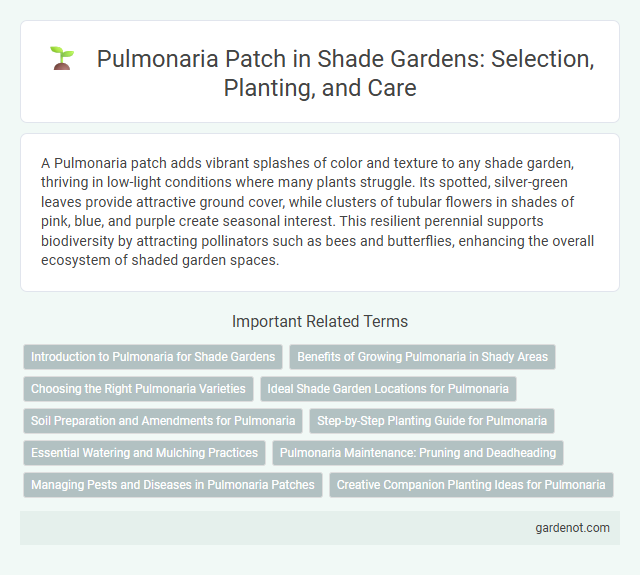A Pulmonaria patch adds vibrant splashes of color and texture to any shade garden, thriving in low-light conditions where many plants struggle. Its spotted, silver-green leaves provide attractive ground cover, while clusters of tubular flowers in shades of pink, blue, and purple create seasonal interest. This resilient perennial supports biodiversity by attracting pollinators such as bees and butterflies, enhancing the overall ecosystem of shaded garden spaces.
Introduction to Pulmonaria for Shade Gardens
Pulmonaria, commonly known as lungwort, thrives in shade gardens due to its preference for moist, well-drained soil and low light conditions. This perennial offers striking foliage with silver spots and early spring flowers in shades of pink, blue, or purple, attracting pollinators. Pulmonaria's ability to tolerate dense shade and suppress weeds makes it an ideal ground cover for shaded areas.
Benefits of Growing Pulmonaria in Shady Areas
Pulmonaria thrives in shady gardens, offering vibrant early spring blooms that brighten low-light areas while attracting pollinators like bees. Its evergreen, spotted leaves provide year-round ground cover, reducing soil erosion and suppressing weeds in shaded environments. The plant's adaptability to moist, well-drained soils enhances garden biodiversity and creates a low-maintenance, visually appealing understory.
Choosing the Right Pulmonaria Varieties
Selecting the right Pulmonaria varieties for a shade garden involves prioritizing species like Pulmonaria saccharata and Pulmonaria officinalis, known for their vibrant foliage and early spring blooms. Varieties such as 'Raspberry Splash' and 'Opal' offer striking leaf patterns and are exceptionally tolerant of low light and damp soil conditions. Opting for cultivars with varying flower colors, from pink to blue, can enhance visual interest and support pollinators in shaded environments.
Ideal Shade Garden Locations for Pulmonaria
Pulmonaria thrives best in part to full shade areas such as woodland gardens, shaded borders, or under deciduous trees where dappled sunlight filters through. It prefers moist, well-drained soil rich in organic matter, making it ideal for shaded garden locations with consistent humidity and protection from harsh direct sunlight. Pulmonaria's adaptability to shady, cool environments makes it a perfect ground cover for spaces that struggle with limited light.
Soil Preparation and Amendments for Pulmonaria
Pulmonaria thrives in well-drained, humus-rich soil with a slightly acidic to neutral pH between 6.0 and 7.0. Incorporate organic matter such as compost or leaf mold to improve soil texture and moisture retention, essential for Pulmonaria's delicate root system. Avoid heavy clay or overly sandy soils by amending with garden loam to maintain consistent hydration while preventing waterlogging.
Step-by-Step Planting Guide for Pulmonaria
Prepare well-drained, humus-rich soil with moderate moisture for optimal Pulmonaria growth. Plant Pulmonaria rhizomes or divisions in early spring or fall, spacing them 12-18 inches apart to allow adequate airflow. Water thoroughly after planting and mulch with organic material to retain moisture and suppress weeds, ensuring a thriving shade garden patch.
Essential Watering and Mulching Practices
Pulmonaria patch thrives in consistently moist, well-drained soil, requiring regular watering to prevent drought stress, especially during dry spells. Mulching with organic materials like shredded leaves or bark around the base conserves moisture, suppresses weeds, and maintains soil temperature. Applying a 2-3 inch mulch layer enhances root health and supports the plant's growth in shady garden environments.
Pulmonaria Maintenance: Pruning and Deadheading
Pulmonaria maintenance involves regular pruning and deadheading to promote healthy growth and vibrant foliage in shade gardens. Removing spent flowers prevents seed formation, redirecting energy toward leaf development and enhancing the plant's overall appearance. Pruning faded or damaged leaves also improves air circulation, reducing the risk of fungal diseases common in shaded, moist environments.
Managing Pests and Diseases in Pulmonaria Patches
Managing pests and diseases in Pulmonaria patches requires vigilant monitoring for common issues like powdery mildew, slugs, and aphids. Applying organic fungicides and using natural predators such as ladybugs helps control infestations without harming the plant or environment. Regular removal of damaged leaves and ensuring good air circulation reduces fungal infections and promotes healthier foliage.
Creative Companion Planting Ideas for Pulmonaria
Pulmonaria thrives in shade gardens when paired with ferns, hostas, and hellebores, creating a lush, multi-textured landscape that enhances visual interest throughout the growing season. Combining Pulmonaria's spotted foliage and early spring blooms with shade-loving bulbs like snowdrops or daffodils adds seasonal contrast and diversity. Incorporating groundcovers such as ajuga or creeping Jenny around Pulmonaria patches promotes healthy soil moisture retention and prevents weed growth, optimizing garden health and aesthetics.
Pulmonaria patch Infographic

 gardenot.com
gardenot.com